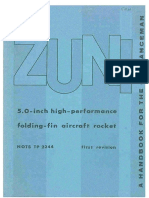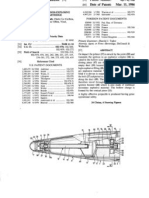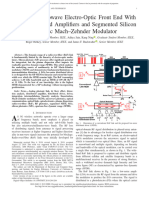Optical Fuze
Optical Fuze
Uploaded by
gattiantonioCopyright:
Available Formats
Optical Fuze
Optical Fuze
Uploaded by
gattiantonioCopyright
Available Formats
Share this document
Did you find this document useful?
Is this content inappropriate?
Copyright:
Available Formats
Optical Fuze
Optical Fuze
Uploaded by
gattiantonioCopyright:
Available Formats
ASC-2004
ADVANCED OPTICAL FUZING TECHNOLOGY
Christian M. von der Lippe*
U.S. Army Armament Research Development and Engineering Center
AMSRD-AAR-AEP-F(A), Adelphi, MD 20783
J. Jiang Liu, Keith Aliberti, Gerard Dang, Wayne Chang, Paul Shen, and George Simonis
U.S. Army Research Laboratory, AMSRD-ARL-SE-EM, Adelphi, MD 20783
ABSTRACT
The intended targets (both area or point) can be
painted with an extremely narrow spot or a large-area
beam depending on the application. Keeping a focused
and directive targeting source is the major advantage of
the optical approach over other fuzing technologies. This
narrow beam allows for a direct fire and flat fire feature
difficult to accomplish with other types of proximity
fuzing schemes. The common RF approach has difficulty
eliminating peripheral ground clutter while still sensing
the target directly in front of the munition. This clutter
resolving capability makes optical fuzing ideal for
ordinance traveling near the earths surface. OF is ideal
for missiles or gun-fired munitions requiring standoffs in
munition functions at ranges in the 10s of meters or closer
with very high range resolution.
We are developing a robust, compact, and affordable
photonic proximity sensor for munition fuze applications.
Successful implementation of this sensor will provide a
new capability for direct fire applications. The photonic
component development exploits pioneering work and
unique expertise at ARDEC, ARL, and Sandia National
Laboratories by combining key optoelectronic
technologies to design and demonstrate components for
this fuzing application [Ruff, et al. 1994; Stann, et al.
1996; Simonis, et al. 2000; Liu, et al. 2000]. The
technologies employed in the optical fuze design are
vertical cavity surface-emitting lasers (VCSELs), the p-i-
n or metal-semiconductor-metal (MSM) photodetectors,
and miniature lenses optics. This work will culminate in
a robust, fully integrated, g-hardened component design
suitable for proximity fuzing applications. This compact
sensor will replace costly assemblies that are based on
discrete lasers, photodetectors, and bulk optics. It will be
mass manufacturable and impart huge savings for such
applications. The specific application under investigation
is for gun-fired munitions. Nevertheless, numerous
civilian uses exist for this proximity sensor in automotive,
robotics and aerospace applications. This technology is
also applicable to robotic ladar and short-range 3-D
imaging.
An OF system consists of a laser transmitter, an
optical receiver, and corresponding electronic signal
processors. Figure 1 illustrates a typical implementation
of an OF for a gun-fired projectile. Mounted on the front
of the projectile, the laser transmits a highly collimated
beam that is amplitude modulated with a chirped RF
signal at frequency f
RF
. Photoreceivers are installed on
the side of the projectile with their electrical bias
modulated at the same time-dependent operational
frequency as the transmitted optical signal. As the
photoreceivers pick up the reflected optical signal from
the target, the on-board signal processor heterodynes
1. INTRODUCTION
Recent developments in Optical Fuzing technology
provided relevant advancement for its application in
precision weapons for the Future Combat System
ordinance. Optical Fuzing (OF) is a promising alternative
approach to standoff fuzing traditionally using RF or
RADAR sensing techniques in situations where a highly
directional sensor is called for. The inherent directivity of
laser emission provides a means of actively sensing
targets in cluttered environments. The ability to achieve
narrow beam focus allows OF to be used in direct fire
munitions. This technology can provide precision Fuzing
for both short and long standoff engagements with
extremely accurate resolution. Since the laser emission is
well focused, the system can remain stealthy and not
easily detected or countered from peripheral locations.
Collimating
Photodetector
Lenses
Laser
Transmitter
Reflected
target signal S&A
Window
Electronics Battery
Boards/Processing
Fig. 1. Illustration of an Optical Fuze for a gun-
fired projectile.
Report Documentation Page
Form Approved
OMB No. 0704-0188
Public reporting burden for the collection of information is estimated to average 1 hour per response, including the time for reviewing instructions, searching existing data sources, gathering and
maintaining the data needed, and completing and reviewing the collection of information. Send comments regarding this burden estimate or any other aspect of this collection of information,
including suggestions for reducing this burden, to Washington Headquarters Services, Directorate for Information Operations and Reports, 1215 Jefferson Davis Highway, Suite 1204, Arlington
VA 22202-4302. Respondents should be aware that notwithstanding any other provision of law, no person shall be subject to a penalty for failing to comply with a collection of information if it
does not display a currently valid OMB control number.
1. REPORT DATE
00 DEC 2004
2. REPORT TYPE
N/A
3. DATES COVERED
-
4. TITLE AND SUBTITLE
Advanced Optical Fuzing Technology
5a. CONTRACT NUMBER
5b. GRANT NUMBER
5c. PROGRAM ELEMENT NUMBER
6. AUTHOR(S) 5d. PROJECT NUMBER
5e. TASK NUMBER
5f. WORK UNIT NUMBER
7. PERFORMING ORGANIZATION NAME(S) AND ADDRESS(ES)
U.S. Army Armament Research Development and Engineering Center
AMSRD-AAR-AEP-F(A), Adelphi, MD 20783; U.S. Army Research
Laboratory, AMSRD-ARL-SE-EM, Adelphi, MD 20783
8. PERFORMING ORGANIZATION
REPORT NUMBER
9. SPONSORING/MONITORING AGENCY NAME(S) AND ADDRESS(ES) 10. SPONSOR/MONITORS ACRONYM(S)
11. SPONSOR/MONITORS REPORT
NUMBER(S)
12. DISTRIBUTION/AVAILABILITY STATEMENT
Approved for public release, distribution unlimited
13. SUPPLEMENTARY NOTES
See also ADM001736, Proceedings for the Army Science Conference (24th) Held on 29 November - 2
December 2005 in Orlando, Florida. , The original document contains color images.
14. ABSTRACT
15. SUBJECT TERMS
16. SECURITY CLASSIFICATION OF: 17. LIMITATION OF
ABSTRACT
UU
18. NUMBER
OF PAGES
6
19a. NAME OF
RESPONSIBLE PERSON
a. REPORT
unclassified
b. ABSTRACT
unclassified
c. THIS PAGE
unclassified
Standard Form 298 (Rev. 8-98)
Prescribed by ANSI Std Z39-18
(mixes) it with a portion of the delayed transmitted
waveform. A distinguished intermediate frequency f
IF
(or
beat frequency) corresponding to the time delay due to the
travel time of the light. Measurement of the f
IF
yields
directly the range information of the target. In the case of
MSM detector, the mixing is achieved by applied the
transmitted chirped signal as a bias to the detector.
Figure 2 shows an example of such a frequency-
modulated continuous wave (FM-CW) operation. The
transmitted laser beam is operated a frequency f
RF
with a
triangular chirping modulation of f over a time period of
T. The time delay between the transmitted and reflected
waveforms from the target will be =2(D/c), where D is
the distance from the sensor to the target and c is the
speed of the light. The range of the target can be
determined in the following relation with measured f
IF
: f
f
IF
=
T
f
T
f
c
D
c
) ( 4D
) 2 )(
2
(
(1)
f
IF
Such a frequency-modulated continuous-wave (FM-
CW) operation provides good resolution in both range and
frequency over the waveform domain. The corresponding
electronic schematic of an OF system is illustrated in
Figure 3. An advanced high-power vertical-cavity
surface-emitting laser (VCSEL) is employed as the
optical transmitter and p-i-n photodiode is employed as
the photoreceiver with the mixing process occurring in a
separate RF circuit. We are also investigating MSM
photodetectors with transimpedance amplifiers as
photoreceivers for a self-mixing detector to eliminate the
need for an electronic mixer. Such an architecture
combines the optical detection and RF mixing into one
component and has the advantage of small signal-to-noise
(S/N) ratio [Shen, et al, 2000].
= 2D/c
F
RF
f
t
T
Fig. 2. Waveforms showing the triangularly chirp
modulation frequency as a function of time for the
transmitted signal (solid) and the returning signal
(dashed) with a time delay .
2. VCSEL AND DETECTOR DEVELOPMENT
In the OF system, an advanced high-power VCSEL is
employed as the optical transmitter source. VCSELs
combine the capability of high-power output with the
superior quality of the laser beam as well as very low
fabrication and packaging costs. The laser beam output
from the transmitter can further be collimated or focused
using external miniature optics to achieve operational
requirement. VCSELs can also be readily flip-chip
hybridized onto associated electronics. MSM
photodetectors/mixers provide advantages of fast
I
Bias
Chirp
RF Power
Generator
Amp.
Power
Splitter
Laser
Transmitted Transimpedence
Trigger
signal Amplifier
Circuit
Bias
Mixer
PROM
Reference
Detector
Lowpass
Returned Filter
signal
Limiter
Mixer Lowpass Decision
Filter Circuit
Fig. 3. A block diagram of the electronics processing system for an Optical Fuze.
2
n-GaAs
Substrate
~
~ ~
~
(~500 m
Thick
Output
~
~ ~
~
Coupling
n-DBR
Optical Cavity
Mirror
Oxidized
MQW gain region Fig. 5. Micrograph of an InGaAs MSM
photodetector whose active area has 10 pairs of
interdigitated fingers and a finger spacing of 3 m.
layers
Back Mirror
p-DBR
p-Contact
~
~
~
~
Heatsink
2.2. InGaAs MSM photodetectors
Interdigitated-finger metal-semiconductor-metal
(MSM) devices have widely been used as high-speed
photodetectors due to their simple structure, high response
speed, low dark current, and processing compatibility
with other semiconductor devices [Aliberti, et al. 2004].
When used as a detector, a dc bias voltage is applied to
the MSM device. As photons are absorbed, electron-hole
pairs are created, and the conductivity of the
semiconductor increases. The detector operates by
registering the number of carriers swept out of the device
per unit time by the applied field, i.e., by measuring the
photocurrent. The electrodes are designed in such a way
as to maximize light transmission into the semiconductor
and, at the same time, minimize carrier transit time.
Interdigitated-finger MSM detectors can also be used as
optoelectronic (OE) mixers to generate radio-frequency
subcarriers in fiber-optic microwave links. When used as
a mixer, the intensity-modulated optical signal is
simultaneously detected and mixed with the modulated
electrical bias to obtain the difference frequency, f
if
. This
frequency conversion is obtained with an ac bias voltage
applied to the device, i.e., a local-oscillator (LO) signal.
Figure 5 illustrates a top view of a MSM photodetector
structure.
Fig. 4. The cross-sectional structure of a VCSEL
flip-chip bonded on a heat-sinking substrate.
responsivity and simplicity in structure and operation.
MSM photoreceivers can function as detectors and mixers
and operate directly in FM-CW mode with simplified
electronic circuits for signal processing.
2.1. 980-nmVCSEL Fabrication
The VCSEL heterostructures were grown by metal-
organic chemical vapor deposition (MOCVD) on an n
+
-
GaAs substrate [Geib, et al. 2002]. The VCSELs consist
of an active quantum-well gain region embedded between
two distributed Bragg reflectors (DBR). A more detailed
description of our VCSEL structure is provided in Figure
4 where it is portrayed in a flip-chip mount onto heat-
sinking or CMOS driver electronics substrates. The
typical mirror composition consists of a 36-period
GaAlAs/Al
0.9
Ga
0.1
As p-doped high-reflectivity DBR and
a 25-period GaAlAs/Al
0.9
Ga
0.1
As n-doped output DBR.
The active region consists of three undoped In
0.2
Ga
0.8
As
quantum wells and GaAs barriers, centered in
Al
0.4
Ga
0.6
As spacer layers to form a single-wavelength
cavity. The emission wavelengths for different VCSELs
with somewhat different quantum-well thicknesses are in
the range of 970 to 980 nm. Two Al
0.98
Ga
0.02
As layers are
placed in the VCSEL structures above and below the
active region for selective lateral oxidation to provide
optical and electrical confinement. A typical high-power
VCSEL device used in the present prototype fuze study
has a 40-m mesa diameter and a 18-m oxidized
aperture.
2.3. Characterization of VCSEL and PD Devices
Electrical current-voltage-optical power (I-V-L)
measurements for such devices showed a current
threshold between 4 to 5 mA and operating voltage of 1.5
to 2.5 volts. Such current threshold is quite acceptable for
the CMOS driving circuits that are used with the
VCSELs. The maxium dc output power achieved was
around 10 mW. The pulsed ac operation using 1 s
pulses demonstrated a power output of 40 mW. More
optical power output can be achieved by increasing the
3
0.0
1.0
2.0
3.0
4.0
5.0
6.0
7.0
8.0
9.0
10.0
0 10 20 30 40 50 60
Injection Current (mA)
0.00
0.50
1.00
1.50
2.00
2.50
3.00
3.50
4.00
4.50
5.00
V
o
l
t
a
g
e
(
V
)
Sandia 980 nmVCSEL
P
o
w
e
r
O
u
t
p
u
t
(
m
W
)
Fig. 7. IV characteristics of a MSM photodetector.
Fig. 6. Current-Power and Current-Voltage
characteristics of a high-power VCSEL device.
size of the aperture and applying appropriate heat-sinking
techniques. Figure 6 shows the current-voltage-optical-
power characteristics of a such VCSEL device.
The wavelength of the VCSEL output was measured
to be 970 nm. GaAs-based MSM photodetectors are not
efficient enough for operation at this wavelength.
Standard InGaAs MSM photodetectors have an excessive
leakage current. It is therefore necessary to design an
optimized resonant-cavity InGaAs MSM structure. The
resonant-cavity MSM-PD OEM structure, grown via
molecular-beam epitaxial technology, consists of a 930
GaAs cap layer, a 1000 InGaAs absorption layer, a 930
GaAs layer, a 829 AlAs layer, and 15 layers each of
695 GaAs/829 AlAs (this is the DBR) all grown on a
GaAs substrate. The electrodes consist of Ti/Au Schottky
contacts deposited via electron-beam evaporation. The
electrodes have 1.5-m finger widths and 3-m spacings.
The intrinsic dark current-voltage (I-V)
characteristics for this MSM structures are shown in
figure 7. The figure shows the dark current for the metal
deposition directly on the top GaAs cap layer. Based on
these results, we decided to fabricate further devices with
the metal deposition directly on GaAs cap layer due to the
much lower dark current. One issue that might arise from
this type of fabrication is the degradation in mixing
efficiency due to the capacitance of the GaAs layer. Such
results have been observed in previously characterized
InGaAs-based MSMs with Schottky enhancement layers.
3. INTEGRATED OPTOELECTRONIC FUZES
The sensor in a proximity fuze for a missile or
projectile application initiates warhead detonation when
the projectile comes within a desired range from the target
where the warhead will produce maximum damage. For
optical sensors, range can be determined with geometric
and opto-electronic ranging technologies. The simplest
technology is geometric ranging, which relies on ranging
effects inherent in the limited transmitter/receiver overlap
regions or parallax in the field of view combined with an
appropriate amplitude threshold in the return signal.
Optical sensors have been built and fielded over the years
for a variety of applications using this approach.
However, it is not always possible to meet stringent
requirements using this geometric approach. When the
requirements cannot be met using this approach, the
solution is to use opto-electronic ranging. This approach
requires higher bandwidth components and greater signal
processing capabilities. Opto-electronic ranging is useful
to generate the ranging function for a long-range system
where the transmitter and receiver beams overlap for
considerable distances and geometric parallax systems
would have significant ambiguity.
4. OPERATION OF OPTICAL FUZES
The ranging theory applied for the optical fuze is an
adaptation of frequency modulation CW (FM-CW) radar
ranging principles. In the simplest sense, the laser
transmitter is amplitude modulated with a radio-frequency
sub carrier which itself is frequency modulated in time.
The target reflected light is incoherently detected with a
photodiode and converted into a voltage waveform
carrying the time-dependent time-delayed modulation
frequency of the return signal. This waveform is then
further processed to recover the target range, as shown in
equation (1) and the basic electronic block diagram of the
sensor architecture in figure 3.
The divergent laser beam is transmitted through a
lens that collimates the light and directs it toward the
target. A small portion of the transmitted light is reflected
4
Fig. 8. A block diagram of the ladar (laser radar) optical sensor system that applied to optical fuze.
from the target back toward the sensor, collected by a
lens, and focused down onto the active region of a
photodetector. The photodetector converts the incident
light power into a current waveform with amplitude
proportional to the light power, or equivalently, the
original chirp waveform. The current waveform is
converted into a voltage waveform by a wideband
transimpedance amplifier. The output of the amplifier is
mixed with an undelayed sample of the transmitted chirp
waveform and the output of the mixer is fed into a low
pass filter to recover an intermediate frequency (IF) signal
f
If
.
In most implementations of the sensor a trigger
circuit initiates the generation of a modulation waveform
that will persist for some time and cycle in a time period
of T. The chirp signal can be simply a sinusoidal
waveform whose frequency of modulation increases or
decreases over time, T. For the architecture described
here, the chirp signal may have a start frequency in the
tens to low hundreds of megahertz and a stop frequency in
the hundreds of megahertz. The difference between the
start and stop frequency, F, is chosen to establish the
desired range resolution R. It can be found that
R=c/(2F), where c is the velocity of light. The chirp
signal is fed into a wideband rf amplifier that modulates
the current driving a solid-state laser diode with
bandwidth at least equal to the chirp waveform.
A laboratory sensor was constructed to demonstrate
the concept viability. A block diagram of the ladar (laser
radar) optical sensor system that is suitable for the OF is
shown in figure 8. A section of the Multi-Option Fuze for
Artillery (MOFA) processor was used with an optical
transceiver. The MOFA processor generates a triangle
wave, which is used to modulate the output of a voltage-
controlled oscillator (VCO). The peak-to-peak level of
the wave determines the modulation bandwidth and the dc
level is used to set the center frequency. The result is a
FM-CW signal centered at 650MHz, with a bandwidth of
+/- 25MHz (frequencies used where for an
implementation of a lab prototype used for demonstration
purposes). The VCO output is divided using a power
splitter. Half of the signal is mixed with the target return
signal to produce an intermediate frequency (IF). The
remaining signal is amplified and used to modulate the
constant current source that drives the laser diode. An
FM-CW waveform is used to modulate the laser in order
to provide more accurate range resolution within the
processor. The bias tee circuit is used to provide an
impedance match between the amplifier and the laser.
The laser emits a beam of light, the intensity of which is
proportional to the drive current. The light is collimated
by a lens system onto the target. The transmitted light
reflects off the target and back to a second lens system,
which focuses the light onto the active region of the
photodetector. The photodiode produces a current, which
is proportional to the intensity of the return signal. This
current is converted into a voltage and amplified. The
amplified signal is mixed with a portion of the original
VCO output to produce the IF signal which is processed
by the MOFA circuit to determine target range.
5
6
5. SUMMARY
To date we have demonstrated a lab system capable
of ranging to 25 meters with commercially available
edge-emitting laser and photodiodes. With these
commercial parts greater distances are achievable with
higher power laser source with larger optical apertures.
However, for this fuzing application and given packaging
and size constraints, neither path is available as a solution.
We have collected results on VCSEL and MSM
components to exploit these devices. Selected
components have been flight-tested and air gun tests have
demonstrated survivability performance to 40 KGs
acceleration. The commercially available components do
not meet our long-term power efficiency and bandwidth
requirements needed to realize adequate performance.
They also fall short in cost and size requirements. Our
goal is to capitalize on VCSELs and MSM photodetectors
advancement to produce a compact, low-cost gun-rugged
optical fuze.
REFERENCES
W. C. Ruff, B. L. Stann, Christian M. von der Lippe,
Ladar Sensor Candidates for a Short Standoff Fuze,
ARL report, (May 19, 1994).
B. L. Stann, W. C. Ruff, and Z. G. Sztankay, Intensity-
modulated diode laser radar using frequency-
modulation/continuous-wave ranging techniques,
Opt. Eng., Vol. 35, No. 11, pp.3270-3278 (Nov.
1996).
G. J. Simonis, H. Pollehn, G. Sztankay, G. Wood, J.
Pamulapati, and J. Mait, Optoelectronics research at
the Army Research Laboratory, Proc. SPIE,
Photodetector Materials and Devices V, Vol. 3948,
San Jose, CA (Jan 22-28, 2000).
J. Liu, B. Lawler, B. Riely, M. Taysing-Lara, K. Olver,
W. Chang, and G. J. Simonis, CMOS-driven
VCSEL-Detector Optoelectronic Interconnects for
Parallel Digital Data Transmission and Processing,
Proc. of 2000 SPIE AeroSense Symposium, Vol.
4046, pp.130- (April, 2000).
P. H. Shen, et. al, Interdigitated finger semiconductor
photodetector for optoelectronic mixing, Proc. SPIE,
Vol. 4028, pp.426-435 (2000).
K. M. Geib, K. D. Choquette, D. K. Serkland, A. A.
Allerman, T. W. Hargett, Fabrication and
performance of two-dimensional matrix addressable
arrays of integrated vertical-cavity lasers and
resonant cavity photodetectors, IEEE Journal of
Selected Topics in Quantum Electronics, Vol. 8, No.
4, pp.943-947 (July-Aug. 2002).
K. Aliberti, W. Ruff, H. Shen, P. Newman, M. Giza, W.
Sarney, M. Stead, J. Damman, R. Mehandru, and F.
Ren, Charactrization of InGaAs self-mixing
detectors for chirp, amplitude-modulated LADAR,
Laser Radar Technology and Applications IX, SPIE
Vol. 5412, pp. 99-110 (2004)
Keywords:
VCSEL, MSM photodetector, optical fuze, ranging,
mixing, optoelectronic processing.
You might also like
- Atp 3.3.4.6 Ed A V1Document26 pagesAtp 3.3.4.6 Ed A V1Jacob Jack YoshaNo ratings yet
- Uav Localization Using Panoramic Thermal CamerasDocument14 pagesUav Localization Using Panoramic Thermal CamerasManoj LNo ratings yet
- Mil DTL 14824CDocument32 pagesMil DTL 14824Cpenoel4142No ratings yet
- SFRJ ProjectileDocument21 pagesSFRJ ProjectileDhimas Afihandarin100% (1)
- 3D6 Smoke Fact Sheet (India)Document16 pages3D6 Smoke Fact Sheet (India)recon506No ratings yet
- Carl Gustaf SAAB - SimulatorDocument2 pagesCarl Gustaf SAAB - SimulatorNickchiosNo ratings yet
- CB 130Document1 pageCB 130shomi86No ratings yet
- 155mm Propelling Charges and Percussion PrimersDocument2 pages155mm Propelling Charges and Percussion PrimersSuleman KhanNo ratings yet
- 500 Volts E1316 Versus 4187Document43 pages500 Volts E1316 Versus 4187gattiantonioNo ratings yet
- YLP-V2-Series 사양서 (E27380 R00)Document4 pagesYLP-V2-Series 사양서 (E27380 R00)Alan OtoniNo ratings yet
- Service Manual CDJ-100SDocument48 pagesService Manual CDJ-100SShannon Rgb100% (1)
- Countermeasures Effectiveness Against Man-Portable Air-Defense System PDFDocument11 pagesCountermeasures Effectiveness Against Man-Portable Air-Defense System PDFFalcao233No ratings yet
- GatorDocument2 pagesGatorultrapampersNo ratings yet
- PGB-128 Precision Gliding BombDocument1 pagePGB-128 Precision Gliding BombgskobicNo ratings yet
- Ar 381-12 Subversion and Espionage Directed Against The UDocument14 pagesAr 381-12 Subversion and Espionage Directed Against The UMark CheneyNo ratings yet
- Miniature Air-Launched Decoy (MALD) and MALD Jammer (MALD-J)Document2 pagesMiniature Air-Launched Decoy (MALD) and MALD Jammer (MALD-J)joma11No ratings yet
- Organizational and Direct Support Maintenance Repair Parts and Special Tools ListDocument47 pagesOrganizational and Direct Support Maintenance Repair Parts and Special Tools ListStefano ColacchiNo ratings yet
- Catherinefc Uk 071005Document2 pagesCatherinefc Uk 071005Panthep PattongNo ratings yet
- Distributed Simulation Testing For Weapons System Performance of The F/A-18 and AIM-120 AmraamDocument17 pagesDistributed Simulation Testing For Weapons System Performance of The F/A-18 and AIM-120 AmraamkepakkoNo ratings yet
- Light Anti-Armour WeaponsDocument5 pagesLight Anti-Armour WeaponsJames100% (2)
- Mt8870 DTMF DecoderDocument17 pagesMt8870 DTMF DecoderLawrence NgariNo ratings yet
- Antenna Pattern Characterization of The Low-Frequency Receptor of LOFAR by Means of An UAV-mounted Artificial Test SourceDocument11 pagesAntenna Pattern Characterization of The Low-Frequency Receptor of LOFAR by Means of An UAV-mounted Artificial Test SourceSudung SitumorangNo ratings yet
- Indra RadarDocument8 pagesIndra RadarDR DONo ratings yet
- SISO-REF-059!00!2015 Reference For UCATT Ammunition Table Approved 20150901Document30 pagesSISO-REF-059!00!2015 Reference For UCATT Ammunition Table Approved 20150901Cotoz AlexandruNo ratings yet
- LM2000AVMDocument18 pagesLM2000AVMweter44No ratings yet
- Mil DTL 45195 Revision FDocument51 pagesMil DTL 45195 Revision FnanocardosoNo ratings yet
- Missile Acceleration Controller Design Using PI and TimeDelay Adaptive Feedback Linearization MethodologyDocument13 pagesMissile Acceleration Controller Design Using PI and TimeDelay Adaptive Feedback Linearization Methodologyscorpion_l_81No ratings yet
- Reshef: Artillery Electronic Time FuzeDocument2 pagesReshef: Artillery Electronic Time FuzeBazil001No ratings yet
- Tehnicheskaya Ekspluataciya Mnogofunkcionalynogo Sverhzvukovogo SamoletaDocument18 pagesTehnicheskaya Ekspluataciya Mnogofunkcionalynogo Sverhzvukovogo Samoletatahir sadikovicNo ratings yet
- AFDD 3-13-1 Electronic Warfare 2011 PDFDocument61 pagesAFDD 3-13-1 Electronic Warfare 2011 PDFMirko Rodríguez ClaureNo ratings yet
- CampionDocument24 pagesCampionJet VissanuNo ratings yet
- Ar380 53 PDFDocument31 pagesAr380 53 PDFsoma0357No ratings yet
- An Israeli Military Innovation: Byralph SandersDocument6 pagesAn Israeli Military Innovation: Byralph SandersSa WajiNo ratings yet
- Mil C 81774a PDFDocument93 pagesMil C 81774a PDFcrrr08No ratings yet
- TM 43-0001-28-3, Guns, Howitzers and Mortars, Interoperable AmmunitionDocument136 pagesTM 43-0001-28-3, Guns, Howitzers and Mortars, Interoperable Ammunitioncaptain americaNo ratings yet
- Rifle Launched MunitionDocument26 pagesRifle Launched MunitionwlamillerNo ratings yet
- NIJ Standard-0307.01Document8 pagesNIJ Standard-0307.01Igor Antonio GranzottoNo ratings yet
- 1959 D149zuni 5.0 Ffar PDFDocument40 pages1959 D149zuni 5.0 Ffar PDFJuan Palomo (Pajarito)No ratings yet
- Mil STD 31000a Released On Assist 3 13 2013Document166 pagesMil STD 31000a Released On Assist 3 13 2013WoofyNo ratings yet
- Rocket Motor Propellant - MK90 Hydra 70 Rocket MotorDocument1 pageRocket Motor Propellant - MK90 Hydra 70 Rocket Motorhdslmn100% (1)
- Ada 224998Document61 pagesAda 224998LalNo ratings yet
- AD0305567(T300破甲弹)Document43 pagesAD0305567(T300破甲弹)114514No ratings yet
- SUBMUNITIONS Identified in Syria - IIDocument1 pageSUBMUNITIONS Identified in Syria - IIarmsresearchNo ratings yet
- AMMO-ID - EditedDocument12 pagesAMMO-ID - Editedessica.landoNo ratings yet
- An-761 Electronic FuzingDocument6 pagesAn-761 Electronic FuzingSait SariNo ratings yet
- Eur 220 enDocument268 pagesEur 220 enapi-3852468100% (1)
- Air To SurfaceDocument7 pagesAir To SurfaceHVNo ratings yet
- Army Direct Fire Accuracy - Precison and Its Effects On The BattlefieldDocument94 pagesArmy Direct Fire Accuracy - Precison and Its Effects On The BattlefieldJerry Buzz100% (1)
- Bore Evacuator Modeling LD08 - 273 PDFDocument8 pagesBore Evacuator Modeling LD08 - 273 PDFehj choNo ratings yet
- Francois Brandt - Armour-Piercing High-Explosive Projectile With CartridgeDocument13 pagesFrancois Brandt - Armour-Piercing High-Explosive Projectile With CartridgeJellomaNo ratings yet
- College of Air Warfare - CLUSTER BOMBSDocument35 pagesCollege of Air Warfare - CLUSTER BOMBSCam EllNo ratings yet
- Guide To Network Defense and Countermeasures 3rd Edition PDFDocument49 pagesGuide To Network Defense and Countermeasures 3rd Edition PDFaitbaddasNo ratings yet
- SDB Boeing Product Card - 11nov2022Document2 pagesSDB Boeing Product Card - 11nov2022Claudio Souza OliveiraNo ratings yet
- Mwo, M122a1, 7Document8 pagesMwo, M122a1, 7David RamirezNo ratings yet
- Mil DTL 2427H1 PDFDocument54 pagesMil DTL 2427H1 PDFffincher4203No ratings yet
- Objective:: 1. The U.S. Navy's "White Cloud" Space Borne ELINT SystemDocument7 pagesObjective:: 1. The U.S. Navy's "White Cloud" Space Borne ELINT Systemanon_151645928100% (1)
- The Health Hazards of Depleted Uranium Munitions (E)Document24 pagesThe Health Hazards of Depleted Uranium Munitions (E)DenisNo ratings yet
- Laser Weapon System (Speed and Accuracy) : Gorgan Maria Madalina Group 2031Document12 pagesLaser Weapon System (Speed and Accuracy) : Gorgan Maria Madalina Group 2031Mădălina Maria GorganNo ratings yet
- Trimble TRM59900 Ti-Choke Ring GNSS Antenna Test ReportDocument7 pagesTrimble TRM59900 Ti-Choke Ring GNSS Antenna Test ReportAkiraTsaiNo ratings yet
- Course Correction FuzesDocument22 pagesCourse Correction FuzesJet Vissanu100% (1)
- FMCW Radar ThesisDocument6 pagesFMCW Radar Thesisjanaclarkbillings100% (2)
- Hossein Zadeh 2019Document13 pagesHossein Zadeh 2019yossof tayelNo ratings yet
- SeekerDocument8 pagesSeekeralper797No ratings yet
- Fabbricazione Parti MetallicheDocument57 pagesFabbricazione Parti MetallichegattiantonioNo ratings yet
- Nasa - A Manual For Pyrotechnic Design, Development and QualificationDocument76 pagesNasa - A Manual For Pyrotechnic Design, Development and Qualificationapi-3770766100% (1)
- Getting Started With Solid Edge v20Document114 pagesGetting Started With Solid Edge v20rocker_srbNo ratings yet
- How To Make Laser Shows: The Complete GuideDocument67 pagesHow To Make Laser Shows: The Complete GuideAsad HashimNo ratings yet
- Ultrafast LaserDocument12 pagesUltrafast LaserKapila WijayaratneNo ratings yet
- Twinkling Stars AustPhys 54 3 May-Jun 2017Document40 pagesTwinkling Stars AustPhys 54 3 May-Jun 2017Cancel AnytimeNo ratings yet
- GLM 42Document82 pagesGLM 42Billy UrbanNo ratings yet
- Series: Suitable For Address Reading and Sensing Cut-Off MarksDocument4 pagesSeries: Suitable For Address Reading and Sensing Cut-Off MarksAntony Jim Ferrari SilvaNo ratings yet
- Vat Photopolymerization ProcessesDocument17 pagesVat Photopolymerization Processeshimanshu singhNo ratings yet
- Fiber Laser PDFDocument2 pagesFiber Laser PDFDavid0% (3)
- 5100 Series Gas Analyzer: Product Data SheetDocument2 pages5100 Series Gas Analyzer: Product Data SheetSai KamalaNo ratings yet
- Physics 2 Pyq Dec 2019Document20 pagesPhysics 2 Pyq Dec 201922405004nilayNo ratings yet
- 02 Electro Medical EquipmentDocument36 pages02 Electro Medical EquipmentDcStrokerehabNo ratings yet
- OFC Lesson PlanDocument3 pagesOFC Lesson Planmanju0071No ratings yet
- KDocument40 pagesKdouhengNo ratings yet
- AWC 708C Manual PDFDocument33 pagesAWC 708C Manual PDFMrDomDomNo ratings yet
- CH 34 - Total SolutionsDocument24 pagesCH 34 - Total SolutionsLemonn LemonnNo ratings yet
- Precitec Laser Cutting Head HP SSL EDocument4 pagesPrecitec Laser Cutting Head HP SSL EErik Marcelo BarrenecheaNo ratings yet
- Sahajanand Laser Technology Ltd. Industry Laser Corporate BrochureDocument2 pagesSahajanand Laser Technology Ltd. Industry Laser Corporate BrochureSLTL GroupNo ratings yet
- XL80 Training Manual (Part 3)Document48 pagesXL80 Training Manual (Part 3)Anonymous swGC2IGNo ratings yet
- SeminarDocument41 pagesSeminarDevikaGNo ratings yet
- PDF Lidar Technologies and Systems 1St Edition Paul Mcmanamon Ebook Full ChapterDocument53 pagesPDF Lidar Technologies and Systems 1St Edition Paul Mcmanamon Ebook Full Chaptermarian.martinez168100% (5)
- 3RD Semester SyllabusDocument17 pages3RD Semester SyllabusAnimesh GarvNo ratings yet
- Operations_Service Manual ExciStar S 200 OEM V.2.0Document103 pagesOperations_Service Manual ExciStar S 200 OEM V.2.0Abdelmonem HamedNo ratings yet
- Yawei CKY Laser Machines Catalog CFFP CFFC CFFTDocument9 pagesYawei CKY Laser Machines Catalog CFFP CFFC CFFTdavidferrerNo ratings yet
- Ce 394Document45 pagesCe 394Cristian AndriescuNo ratings yet
- SPP 2017 Conference HandbookDocument48 pagesSPP 2017 Conference HandbookGhirlie Eunice LopezNo ratings yet
- Geometrical Optimization of A Longitudinal Resonant Photoacoustic Cell For Sensitive and Fast Trace Gas DetectionDocument10 pagesGeometrical Optimization of A Longitudinal Resonant Photoacoustic Cell For Sensitive and Fast Trace Gas DetectionDownote ManNo ratings yet
- Streamlight's TLR VIR II - White Light and IR Illumination With Laser in One Sleek PackageDocument3 pagesStreamlight's TLR VIR II - White Light and IR Illumination With Laser in One Sleek PackageTwobirds Flying PublicationsNo ratings yet
- Doc-20241023-Wa0003 241105 102047Document50 pagesDoc-20241023-Wa0003 241105 102047aditya.j.patwaNo ratings yet




























































































